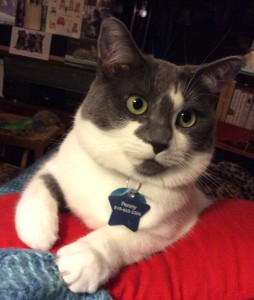 We introduced Bobbi Florio Graham yesterday in Part 1 of this series. She mentioned her current cat, Penny. QT Penny (Quattro Teakettle) is her fourth cat since she adopted Simon Teakettle, the owner of her company, in 1972. As she says, “I added Q.T. for Quattro Teakettle, in honor of Terzo, who was Simon Teakettle III. But I realized it could also mean “Cutie” and I often call her Cutie Pie as well as Cutie Penny.”
We introduced Bobbi Florio Graham yesterday in Part 1 of this series. She mentioned her current cat, Penny. QT Penny (Quattro Teakettle) is her fourth cat since she adopted Simon Teakettle, the owner of her company, in 1972. As she says, “I added Q.T. for Quattro Teakettle, in honor of Terzo, who was Simon Teakettle III. But I realized it could also mean “Cutie” and I often call her Cutie Pie as well as Cutie Penny.”
And Penny is a cutie—that’s her in the photo.
To remind you, Barbara (Bobbi) Florio Graham won the $1,000 Sticky Paws award for best article on training at the Cat Writers’ Association annual conference in 2002. Here’s Bobbi’s blog post:
Every cat is different, and training methods have to be adapted to that animal’s individual personality.
I adopted the first Simon Teakettle when he was 18 months old. It was clear he’d been hit by a rolled-up newspaper, perhaps when he tried to dash through the door, because he was startled any time he heard the rustling of any paper.
I didn’t have that problem with the second or third Simon Teakettles, whom I raised from kittens, but Simon II (Tiki) was a part-Siamese feral, who presented distinct challenges.
I’ve never encountered a cat so smart! I had to buy him new toys and invent new games just to keep him occupied, as he was easily bored.
Simon III (Terzo) was the opposite. A black and white sweetheart, he was placid and cuddly, eager to please and willing to learn.
He’s the cat featured in the video which has received much praise from animal behaviorists. It’s at: http://lnkd.in/fKsbhH
I found Q.T. Penny at a local shelter in February of 2015. She was a year old, had been a stray, and was still pretty skittish when I brought her home. But she already knew her name, and began to come when I called her within the first few days.
It’s confusing to change the name of an older cat. I added Q.T. (for Quattro Teakettle) and she now responds to both “Q.T.” and “Penny.”
I start with “Come here,” and only call Penny when she will receive a reward for obeying.
It helps when you call the cat when you have full dish in your hand! I began by calling Penny to her tray when I fed her, and gradually began to insist that she sit by her tray in order for me to put the food dish down.
Now when she wants her wet food, all I have to do is say “Sit by your tray,” and she goes there, sits, and waits for me to bring the dish to her.
I always begin training using dry cat food, and only move to treats much later, when I start to teach special behaviors. I believe strongly in positive reinforcement, and my experience has been that cats react to praise and petting.
There are a couple of important things to remember. Always use the cat’s name when you praise him or her, and never when scolding. I always reinforce good behavior with “Good girl.” For any behavior I want to discourage, I employ a very loud and sharp “No!” accompanied by a loud noise, usually clapping my hands.
It’s important for every pet new to the household to learn “Sit” and “Stay,” and cats should be leash-trained, even if you never plan to let them go outside. It’s a matter of safety, in case you ever have to leave quickly without time to put the cat into a carrier.
In Part Three, I’ll discuss other commands, and the importance of consistency.
Barbara Florio Graham is an author and publishing consultant whose business is named after The Cat Who Owns the Company. Her website: http://SimonTeakettle.com contains Simon Teakettle’s blog, fan club, and a great deal of information about cats (as well as many other subjects). Here’s the link to the training article: http://SimonTeakettle.com/training.htm To learn the interesting story about how Simon Teakettle got his name, go to http://SimonTeakettle.com/simont.htm





